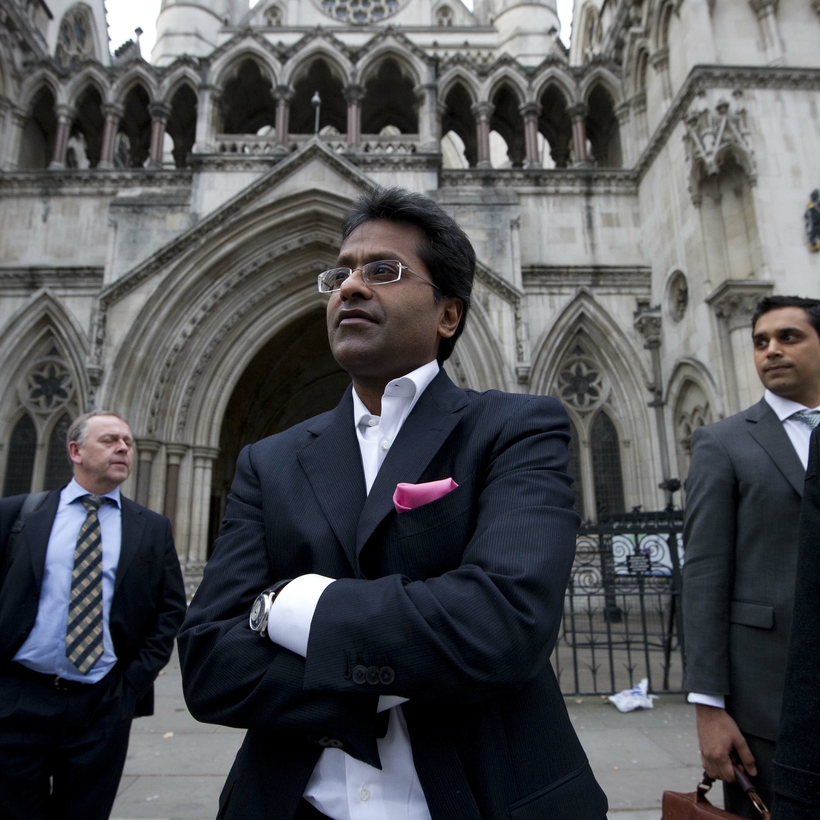In the esoteric sport of cricket, a “googly” is a wrist-spun ball that breaks toward the off side despite being bowled with a right-arm leg spinner’s action out the back of the hand. If that all sounds like nonsense to you, then that’s sort of the point. It is a bamboozler of a thing, a play designed to deceive the opposition with subterfuge, misdirection, and sleight of hand. On the pitch, it is politely applauded—one of the finest ploys in this game of infinite ploys. But off the pitch? Well … as a gentleman of a certain age and waistline might declare: It’s just not cricket.
Lalit Modi, the multi-millionaire who founded the world’s most lucrative cricket league, preferred to bowl his googlies away from the arena, so to speak—at meetings in suites at the Four Seasons Resort Dubai, say, or in glossy, splashy pitch decks for his shiny, new investment opportunity.
The business in question was an allegedly revolutionary single-dose radiation therapy dubbed “Ion Care.” And his preferred gambit, it now appears, was the name-drop bait and switch. This past week, it emerged in The Sunday Times of London that Modi was being sued for nearly $7 million in London’s High Court after having allegedly convinced international investors to pour their money into his scheme, based on the warm and ringing endorsement of a whole host of international grandees. The only problem was: it appears that none of them knew a thing about it.

Modi is alleged to have shown an investor a phony roster that read like a social climber’s dream dinner-party guest list—imaginative and predictable all at once. King Felipe and Queen Letizia of Spain were apparently sweet on Ion Care, as was Princess Haya bint Hussein of Jordan. Kofi Annan—the former U.N. secretary-general—was a fan; not to mention Sheikh Mansour bin Zayed Al Nahyan, deputy prime minister of the U.A.E. and the billionaire owner of Manchester City F.C. Oh, and Thaksin Shinawatra, the ex–prime minister of Thailand. And international football star Cristiano Ronaldo. And Roger Federer, if that name means anything to you. (Modi denies all charges.)
The most intriguing name-drop of all, however, is Modi’s frequent mention of Prince Andrew. It seems, at first glance, an impossible overreach. And yet, somehow, it’s the most plausible of the lot. The prince has rarely met a shady foreign potentate he didn’t like, after all, and is said to have visited the financier’s seven-story town house in West London a few years ago. (A spokesman for the prince told The Sunday Times that he had “never been a patron of Ion Care and had no knowledge of its existence.” The spokesman might also have been forgiven for adding, “And we have slightly bigger fish to fry right now.”)

Either way, the royal endorsement sealed the deal for Gurpreet Gill Maag. A former model from India turned venture capitalist who now goes by the name Blu, she is the woman responsible for bringing the case to the High Court. Gill Maag popped $2 million into the cancer start-up after Modi told her that a similar treatment had been used with great success on his wife in Lisbon. Plus, “he said Prince Andrew was a very dear friend of his,” Gill Maag told The Sunday Times. “And he looked forward to introducing us over dinner the next time we were in London.”
The most intriguing name-drop of all is Modi’s frequent mention of Prince Andrew.
That particular invitation may have lost a little luster of late. And, anyway, a quick Google search might have raised a few red flags on the whole caper. To start, Modi only came to London in 2010, after the money-drenched Indian Premier League tournament he founded became ensnared in accusations of match-fixing and fraud. With further allegations of “individual misdemeanors” against Modi personally, he was exiled from the Indian cricket community and fled for England—claiming, as calls rose for him to return to face the music—that he was an assassination target of the Mob.
London welcomed the alleged fraudster with open arms, as London tends to do. Modi’s rented town house sat on the handsome Cadogan Square in ultra-prime Chelsea. His red Ferrari—spotted down in Monaco and just one of his armada of supercars—bore the license plate “CR13KET.” On Christmas Day, missing his son, Ruchir, the impresario walked past a Ferrari dealership and bought the 27-year-old a brand-new 488 Spider on the spot and “on a whim,” according to an Instagram post. Other photos on his social media show a cascade of blue infinity pools, luxury hotel balconies, and reclining private-jet seats.
Putting forward his defense in filings at the High Court, Modi has stated that “the personalities mentioned were illustrative of the kinds of person [he] envisaged in the role of patron,” and that he “intended to approach some or all of those people with a view to inviting them to participate” in Ion Care.
This is plucked from the “If you build it, they will come” school of fundraising—a piece of grade-A hook-wriggling that sits somewhere between wildly deluded and flatly fraudulent. But it’s worth a go, at least. Modi is being sued by Gill Maag for almost $7 million in total, to account not only for the $2 million squandered in Ion Care (which went bust in 2019) but also for “the loss of opportunity” from other potential investments. The multi-millionaire Modi appears to be as good at raising money as he is at spending it. It will soon become clear, however, whether he also has a talent for holding on to it.
Joseph Bullmore is a Writer at Large for AIR MAIL

